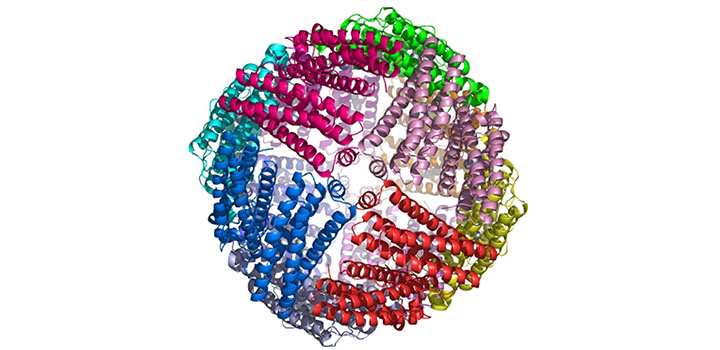Unusually high anti-oxidant activity discovered in bacterial iron-storing protein
By: Communications

Ferritins are a family of football-shaped proteins that are found in all type of cells. Like a football, the protein is hollow, but when it encounters iron in solution, it oxidises and deposits the iron within its internal cavity as a rust-like mineral. This not only removes potentially toxic iron from solution but also provides a store of it for potential future use (when iron becomes scarce).
Bacterioferritin from the gut bacterium Escherichia coli (shown above) belongs to a subclass of ferritins that is unique because members contain another form of iron called heme. The biochemical role of the heme was not clear for a long time but was recently shown to be related to the release of iron back to solution when cellular iron levels drop.
The team, involving researchers at the University of Essex, the University of East Anglia and Grenoble Alps University (France), have demonstrated that the primary role of this bacterioferritin is not to store iron; rather, it is to remove the dangerous oxidant hydrogen peroxide, with iron storage most likely being a secondary function. The researchers also discovered a direct route for electron transfer between the heme and the site of reaction with hydrogen peroxide, thus revealing how the heme may play a key role in the peroxide detoxification process when iron is released.
Prof Nick Le Brun, who led the UEA component of the work, said:
“We showed many years ago that bacterioferritin can use both O2 and the dangerous oxidant hydrogen peroxide to oxidise iron and deposit it within its protein shell. We have now discovered that peroxide is a thousand times more efficient than O2 in iron oxidation. This changes our view of the protein’s function – it is not about collecting iron – that is done by another ferritin protein in the bacterium. It is more about using iron to reduce harmful hydrogen peroxide to harmless water.
"The discovery of a new role for heme in bacterioferritin, as a conduit for electrons to reduce hydrogen peroxide, is exciting because it starts to answer an overarching question of how the protein continues to play an anti-oxidant role even when there is no iron available to oxidise and store. Again, this shifts the way we view the main role of the protein away from storage of iron to anti-oxidant.”
The team are currently applying this new insight to investigate the detoxification role a human ferritin under similar oxidative stress conditions.
The research was recently published ahead of print in two papers in the journal Angewandte Chemie International Edition journal:
- Iron oxidation in Escherichia coli bacterioferritin ferroxidase centre, a site designed to react rapidly with H2O2 but slowly with O2
Pullin et al, Angew Chem Int Ed Engl. 2021 Jan 22. doi: 10.1002/anie.202015964.
- Electron transfer from haem to the di-iron ferroxidase centre in bacterioferritin
Pullin et al, Angew Chem Int Ed Engl. 2021 Jan 18. doi: 10.1002/anie.202015965.
Related Articles

Innovation and Impact Awards now open for entries and nominations
The Innovation and Impact Awards are back for 2025 and looking to recognise and reward UEA’s most game changing staff, students, and graduates, and their collaborative work with partners outside the University.
Read more
How quantum light sees quantum sound
Researchers at the University of East Anglia have proposed a new way of using quantum light to ‘see’ quantum sound.
Read more
How nitrogen-fixing bacteria sense and respond to iron
Researchers in the School of Chemistry at UEA have taken an important step forward in understanding how a group of bacteria that include nitrogen-fixers and important animal pathogens sense the essential micronutrient iron.
Read more